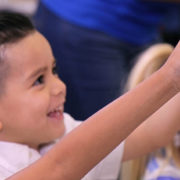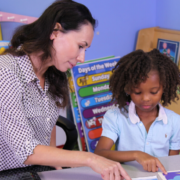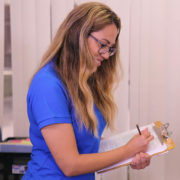How to Build Independent Living Skills in Your Child With Autism
Daily, independent living skills or self-care skills are those skills that people use every day to maintain their appearance, health, and hygiene. These small tasks include brushing teeth, showering, chores, and getting dressed. These are arguably some of the most important skills in a person’s repertoire. These skills provide a person with the autonomy to live on their own or with minimal support.
Many of our learners with autism may need extra support to learn these important skills. For some families, caregivers have to complete these tasks for their child, adding to additional stress on the family. By their children with autism learning these skills, stress can be reduced for the caregivers.
By ensuring your child with autism has all the necessary skills to care for themselves, ensures you are encouraging independence and setting them up for success in the future.
Here are some tricks to help develop independent living skills in your child with autism.
- Pick the Skill to Focus First
When starting to focus on teaching your learner more independence, try selecting just one skill to focus on in the beginning. After you gain some momentum, then add more skills to start practicing. When looking at your first skill to target, consider starting with a skill that your learner can already do some steps on their own first. This will help both you and your learner with autism gain some confidence as you start teaching these skills.
- Break Big Skills into Tiny Steps
When you have selected your target skill, research shows that breaking the skill down into small steps and focusing on each step individually can be very successful when teaching learners with autism. This method of breaking a large skill into small steps is called a task analysis. These steps in a task analysis are chained together, step-by-step, creating an easy to remember routine.
Think about each tiny skill that goes into just tying shoes or brushing teeth! By targeting each small step on its own, you have the opportunity to make sure your child with autism masters each step in skill before moving on to the next! This also creates a consistent way to complete the skill, so that everyone in the family is teaching the skill in the same order.
Here are some example tasks analysis for some common daily, independent living skills. If you are targeting a skill not listed, here are the steps to make your own!
- Complete the skill yourself! As you are completing the skill, make a note every time you move from one step to the next. Go ahead and write this list down.
- Get help! Have someone else complete the steps on your list, following your instructions. Tell them each step and the order to do them. Go ahead and correct any steps you may have missed or if something doesn’t flow.
- Make a final list and start practicing! I recommend writing a final list and posting it wherever the skill will take place. I also recommend finding a way to track how your learning is making progress. A data collection sheet is a great way to record if your learner completed the step on his own or with some help!
Example Task Analysis Of Brushing Teeth:
- Get toothbrush and toothpaste
- Open toothpaste
- Put small amount of toothpaste on toothbrush
- Turn on water
- Wet toothbrush
- Turn off water
- First, brush bottom left for 10 seconds
- Next, brush bottom right for 10 seconds
- Then, brush top right for 10 seconds
- Last, brush top left for 10 seconds
- Spit
- Brush top front for 10 seconds
- Brush bottom front for 10 seconds
- Spit
- Turn on water
- Rinse brush
- Rinse sink
- Turn off water
- Wipe mouth
- Put away toothbrush and toothpaste
- How and When to Prompt!
Prompting (helping) your child with autism is going to teach your learner how to complete the self-help skill on their own. When teaching self-help skills, it is recommended to use physical prompts. Physical prompts are providing physical guidance for your learner to complete the skill. Light physical guidance, would be gently guiding your learner to complete the step you are currently focused on. This may look like a gentle touch on the elbow, guiding hands to the sink.
Hand-over-hand physical guidance is completely guiding your learner to complete the step. This may look like your hand over your child’s hand, guiding them to brush their teeth. In the beginning, your learner may need more hand-over-hand guidance. As your learner gains the target skill, you should see them requiring less and less support.
When teaching each tiny step, we recommend giving your learner the chance to do the first step independently.
For example – This looks like giving your learner a general instruction, like “put on your deodorant” and then you count to three. This gives your learner the chance to respond correctly. If your learner does not complete the step, help them by lightly guiding their elbow to complete the task.
For example – If you are teaching your learner to put on deodorant and working on the step for rubbing the deodorant under her armpit, you may guide their hand under their underarm to their armpit. If they do not start to rub the deodorant under their armpit, you can try grabbing their wrist and rubbing the deodorant hand back and forth with them.
Even if your learner does not know how to do it, they are getting the practice of completing the step!
Only provide the instruction for the skill. After your learner completes a step (with or without your help) count to three and then provide help by first providing the gentle guidance, and if more help is needed, then provide hand-over-hand assistance. When you are helping your child, try to avoid providing verbal prompts (verbally telling them what to do) and focus on physically guiding them.
Remember, you want them to eventually complete these activities when you are not present to TELL them how to complete the steps. By telling them or doing the task for them, you risk them not learning how to complete without your presence.
Remember to Use Reinforcement
Reinforcement is a key component in teaching independent living skills! This lets your learner know what steps they are doing correctly. Reinforce a small bite of your learner’s favorite snack, extra tablet time, or access to special activities. If your learner has a token board, this is also a great time to deliver tokens! As they are completing each step, give them praise for doing it. This will help your learner know when they are doing it right! At the end of the total skill, give your learner a reward when they are completing the skill with less help or if they had completed a step that they usually need assistance on without help.
Tips for future self-care skills
Visuals can Help!
Visuals with pictures of each step in a routine or daily living skill can be effective in increasing the independence of your learner. This is super helpful when your learner’s routines continue to grow.
For example – if you teach your learner all the steps in getting ready for school, then the next step is for them to do all the steps without giving each instruction.
However, this can be a lot of things to remember! Giving them pictures of each instruction is a simple way to create more independence in your learner’s day to day life.
Practice Future Skills
Think about the age of your child and the skills they may need in the next 1-2 years.
For example – if your daughter is 10, don’t wait to start teaching her how to change a pad! Think about all the steps that can go into that, and we want to make sure she has those skills before she needs them. Also, consider that wearing a pad may be uncomfortable for many of our girls with autism. They may need to learn to tolerate that uncomfortable feeling. This may also be the same with deodorant. The cool sensation under some children with autism may be uncomfortable due to their sensitivity to different sensations.
Learning to Tolerate
It is not uncommon for children with autism to dislike the sensory parts of some independent living skills. If problem behavior is occurring, I do recommend consultation with a BCBA. In the meantime, go back to baby steps. Start with just a second with the uncomfortable sensation and then immediately reinforce if problem behavior did not happen. When your learner can tolerate the uncomfortable situation for a second, increase it to 2-3 seconds. Provide reinforcement when they are tolerating that sensation without problem behavior. Continue to increase the time your learner tolerates the situation until they can be present for enough time to complete the task.
For example – if your child with autism is scared of the bathroom, they need to tolerate the restroom for at least 2-3 minutes to be able to complete that task.
If your learner is engaging in behaviors that may be dangerous to themselves or others, contact a BCBA as soon as possible to provide an individually based treatment plan to ensure your child with autism acquires the necessary self-help skills safely.
Practice as Often as Possible!
While it is probably impossible to practice a skill 5 times a day, create a reasonable goal for your family to practice these skills. I recommend at least 3-5 times per week to practice a skill. Try setting up a routine for yourself, so that practice just becomes part of your schedule. By providing your learner with ample opportunities, you are decreasing the time it will take your child with autism to learn the skill.
Be Patient!
The final tip is to be patient and consistent. Teaching self-help skills can be trying and may take some time. The most important thing is to be consistent and be patient. Remember, you are pushing your learner with autism towards a more independent life.

DANIELLE DUPUIS
Title: BCBA
Danielle Dupuis is a Board Certified Behavior Analyst from Lafayette, Louisiana. She received her Bachelor of Science in Psychology from the University of Louisiana at Lafayette. Following this, she earned her Master’s degree in Applied Behavior Analysis at the University of Houston-Clear Lake.
Danielle gained experience as a therapist in the Applied Behavior Analysis-Skills Early Intervention Program (ABA-SkIP) at the Center of Autism and Developmental Delays creating interventions for children with autism. Danielle also worked alongside teachers as a behavioral consultant in Clear Creek Independent School District to assist teachers in managing problem behaviors.











